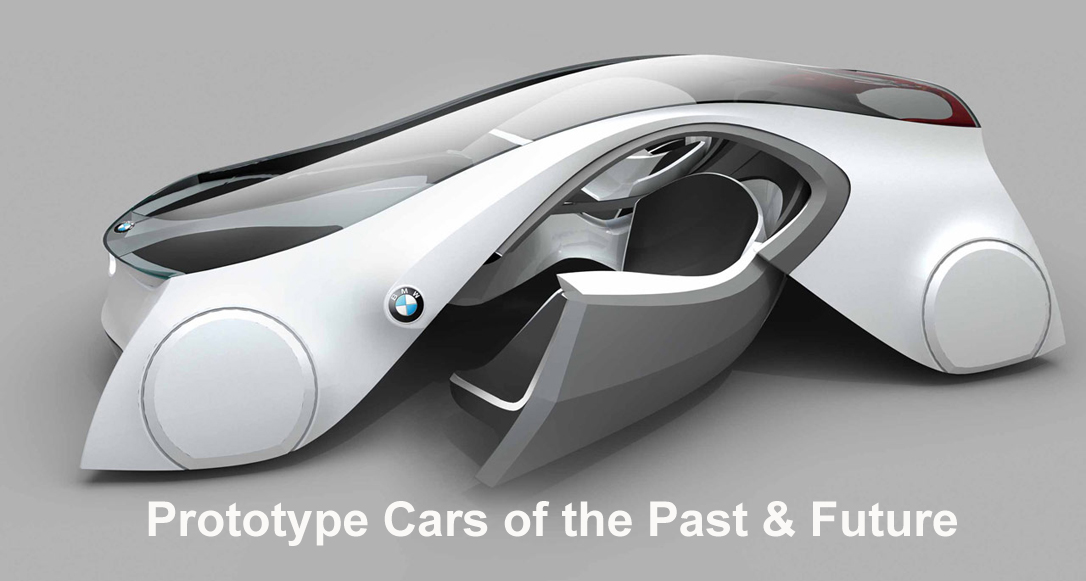

(continued)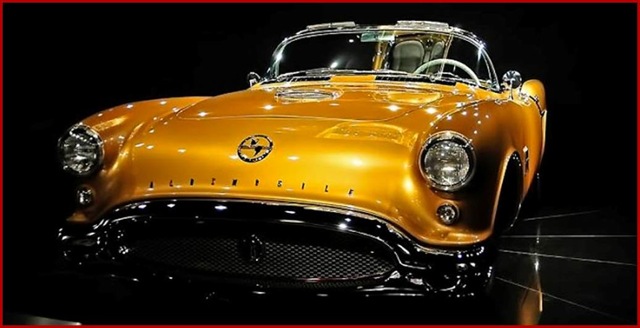
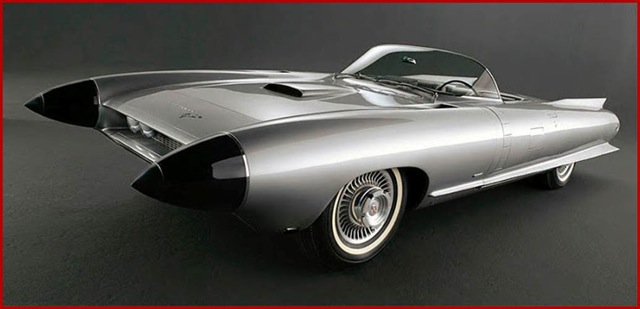
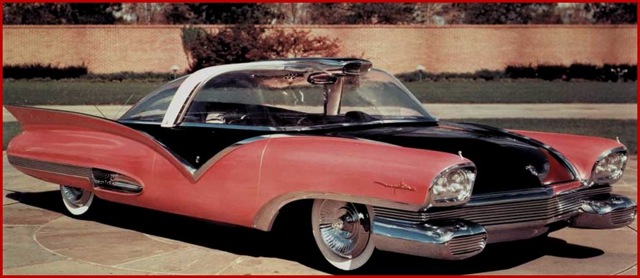
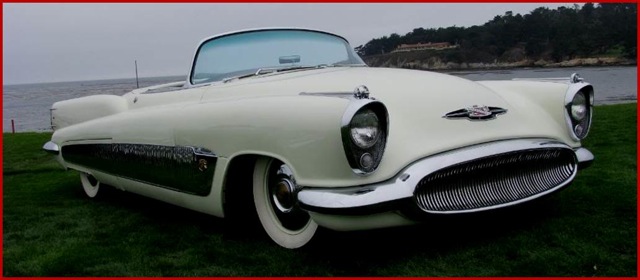
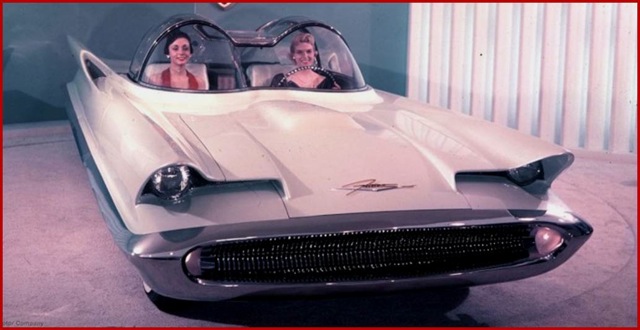
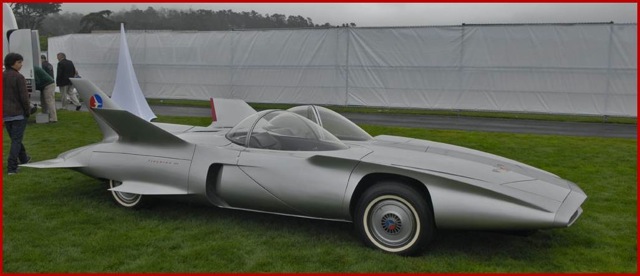
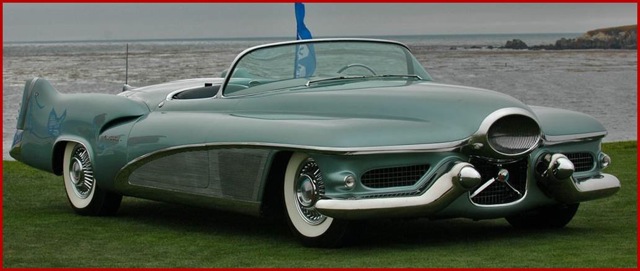
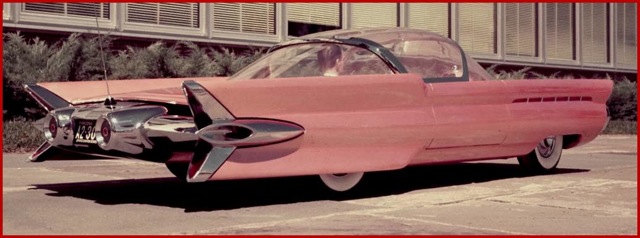
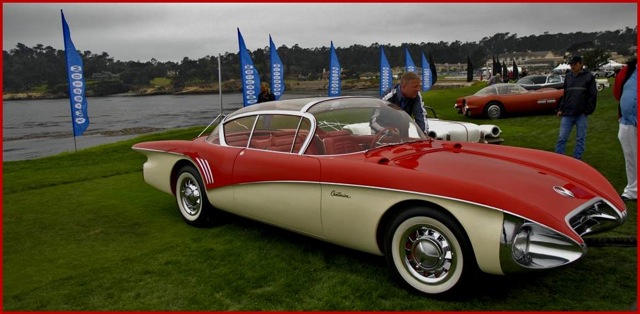
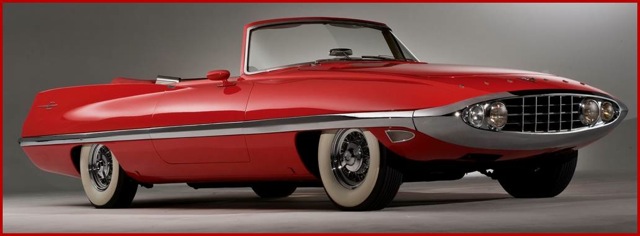


The 1954 Oldsmobile Rocket
" Harley Earl, the legendary automotive stylist, designed the F-88 under the belief that it would have outsold the Corvette and forever changed automotive history. Unfortunately Chevrolet, which produced more GM products than any of its other divisions, convinced the GM board of directors to cut the Oldsmobile project. The F-88 never went into production due to that sabotage combined with lukewarm Corvette sales. The 1954 Oldsmobile F-88 was strictly ever a dream car."

The 1959 Cadillac Cyclone
Built in 1959, it is one of Harley Earl's last designs. Its futuristic styling was heavily influenced by 1950's aviation and rocketry.

The 1954 Ford Mystere
As much as the Ford Mystere was a product of the jet age, it was also a product of the atomic era. Its multiple antennae and air scoops made it prepared for whatever whiz-bang devices man had invented or could possibly dream of creating. A telephone, television and button and lever controls gave it a futuristic feel inside. On the outside, its jet-age influence was most visible in its clear-roof canopy, twin jet-plane rear exhaust ports and its long, low stance that made it appear as though it was hovering above this planet or the next. It was a package that George Jetson would have proudly ridden to a day at Spacely Sprockets.
For all of its futurism, the wild Mystere featured traits that would appear on production Fords. The side trim made it to 1955 and '56 Fords and the fins to 1957 Fords. It's easy to picture Junior playing with his Robby the Robot from the back seat while Mom prepared pills for a picnic warmed in the in-car microwave oven.Although the Mystere swooped into the hearts of showgoers during the late 1954 show season, its subsequent history is a black hole.

The 1951 Buick XP300
Envisioned by Charles Chayne, head of GM Engineering at the time, the Buick XP 300 was conceived as an experiment in styling and engineering. The lightweight aluminum body and skirted rear wheel openings make the XP 300 appear as if it is floating. Coupled with a high horsepower engine, Charles Chayne himself tested the XP 300's performance by reaching more than 140 miles per hour during an engineering test run.

The 1955 Lincoln Futura
Before it was the Batmobile it was the 1955 Lincoln Futura concept car. The Batmobile-to-be was the brainchild of Lincoln Mercury's postwar chief stylist, Bill Schmidt. Inspired by a scuba-diving encounter with a shark, Schmidt sketched a low, long, wide, and flat vision of the future with a predatory full width grille, ominously hooded headlights, and killer tail fins. Built by Ghia in 1954, the $250,000 dream car was dubbed the Lincoln Futura. It took just three months to ready the concept car for its debut at the Chicago Auto Show in January 1955. From there, the futuristic Lincoln was driven to a show in Detroit. On March 3rd, just before the NY Auto Show, with Benson Ford at the experimental steering wheel and Schmidt in the passenger seat, the Futura cruised from the United Nation's building through Central Park to the Tavern on the Green (restaurant) for a photo session. The Futura went on The Ed Sullivan Show, which Lincoln sponsored, then to a guest shot on Dave Garroway's TV Show.

The 1958 GM Firebird
Motorama car shows were a fixture of the fabulous Fifties and fans of The General's futuristic visions couldn't wait to see what next year’s show would bring. The pressure of continually improving on the most futuristic designs possible led to some truly bizarre concept cars. By 1958 things were really getting out of hand, as illustrated by the outlandish Firebird III.

The 1956 Buick Le Sabre

The 1954 Ford LaTosca
Ford La Tosca concept car was designed by Alex Tremulis. The La Tosca evolved into the design for the '58 Lincoln.

The 1956 Buick Centra
Buick first used the Century nameplate in the 1930s, commemorating its ability to exceed 100 mph. The year to see a Buick wearing the 'Century' name in the post World War II was in 1954. This model had Buick's most powerful engine in the smallest model, and fitted with tastefully understated bodywork. The Century's 'Fireball' overhead-valve V8 engine was capable of producing 255 horsepower in 1956. Zero-to-sixty took less than ten seconds, with the quarter-mile times of around 17 seconds and a top speed exceeding 110 mph.
The Century was styling, with the four oval 'ventiports' and leather trim. For 1956, Buick built just 4,721 Century Convertible Coupes.

The 1956 Chrysler Diablo
Here is the extremely rare and stunning 1957 Chrysler Diablo, also the result of collaboration with Ghia and considered the most valuable concept car from the 1950s.

How Are Cars Actually Designed?
From wikipedia the free encyclopedia.
Automotive design is the profession involved in the development of the appearance, and to some extent the ergonomics, of motor vehicles or more specifically road vehicles. This most commonly refers to automobiles but also refers to motorcycles, trucks, buses, coaches, and vans. The functional design and development of a modern motor vehicle is typically done by a large team from many different disciplines included within automotive engineering. Automotive design in this context is primarily concerned with developing the visual appearance or aesthetics of the vehicle, though it is also involved in the creation of the product concept. Automotive design is practiced by designers who usually have an art background and a degree in industrial design or transportation design.
Design elements
The task of the design team is usually split into three main aspects: exterior design, interior design, and color and trim design. Graphic design is also an aspect of automotive design; this is generally shared amongst the design team as the lead designer sees fit. Design focuses not only on the isolated outer shape of automobile parts, but concentrates on the combination of form and function, starting from the vehicle package.
The aesthetic value will need to correspond to ergonomic functionality and utility features as well. In particular, vehicular electronic components and parts will give more challenges to automotive designers who are required to update on the latest information and knowledge associated with emerging vehicular gadgetry, particularly dashtop mobile devices, like GPS navigation, satellite radio, HD radio, mobile TV, MP3 players, video playback, and smartphone interfaces. Though not all the new vehicular gadgets are to be designated as factory standard items, some of them may be integral to determining the future course of any specific vehicular models.
Exterior design
The stylist responsible for the design of the exterior of the vehicle develops the proportions, shape, and surfaces of the vehicle. Exterior design is first done by a series of digital or manual drawings. Progressively, drawings that are more detailed are executed and approved by appropriate layers of management.
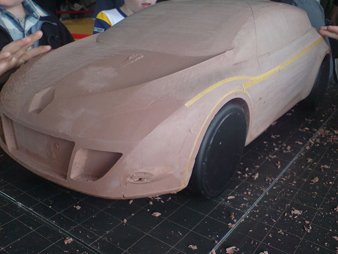
Clay (industrial plasticine) and or digital models are developed from, and along with the drawings. The data from these models are then used to create a full sized mock-up of the final design (body in white). With three- and five-axis CNC milling machines, the clay model is first designed in a computer program and then "carved" using the machine and large amounts of clay. Even in times of high-class 3d software and virtual models on power walls, the clay model is still the most important tool to evaluate the design of a car and therefore used throughout the industry.
Interior design
The stylist responsible for the design of the vehicle interior develops the proportions, shape, placement, and surfaces for the instrument panel, seats, door trim panels, headliner, pillar trims, etc. Here the emphasis is on ergonomics and the comfort of the passengers. The procedure here is the same as with exterior design (sketch, digital model and clay model).
Color and trim design
The color and trim (or color and materials) designer is responsible for the research, design, and development of all interior and exterior colors and materials used on a vehicle. These include paints, plastics, fabric designs, leather, grains, carpet, headliner, wood trim, and so on. Color, contrast, texture, and pattern must be carefully combined to give the vehicle a unique interior environment experience. Designers work closely with the exterior and interior designers.
Designers draw inspiration from other design disciplines such as: industrial design, fashion, home furnishing, architecture, and sometimes product design. Specific research is done into global trends to design for projects two to three model years in the future. Trend boards are created from this research in order to keep track of design influences as they relate to the automotive industry. The designer then uses this information to develop themes and concepts that are then further refined and tested on the vehicle models.
Graphic design
The design team also develops graphics for items such as: badges, decals, dials, switches, kick or tread strips, liveries.